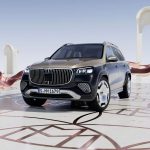Making the world marvel at the cars with the two-letter logo is the goal that Maybach aims for, just like how they used to marvel at Bentley or Rolls-Royce cars. The history of this car manufacturer also has many things to talk about.
August Wilhelm Maybach, the founder of Maybach Manufaktur, started his career with a specialization in technical drawing. Since 1872, when he took on the role of chief designer at the Deutz engine factory, he had been planning to design a 4-stroke engine based on Nikolaus Otto’s invention.
In 1877, under Maybach’s direction, the first 4-stroke engine in the world took shape and was ready to be mass-produced. Five years later, when Gottlieb Daimler established Daimler Motor Company, Maybach was invited to be the technical director. Here, Maybach and Daimler together designed a steel-wheel car, a V2 4-stroke engine, and a 4-speed transmission. However, it was only when Maybach left Daimler Motor in 1907 that his career in the automotive industry truly took off.
At the age of 61, Maybach found a new passion for airplanes, starting with designing 150 horsepower engines for the LZ1 Zeppelin aircraft company. In 1909, Whilhelm Maybach and his son Karl Maybach founded the Aircraft Motor company as a direct branch of Zeppelin Airship company. During World War I, the aircraft manufacturing industry flourished to meet the needs of the military. Aircraft Motor expanded significantly and changed its name to Maybach Motor in 1918.
The end of the war also marked a harsh constraint on Germany’s aircraft manufacturing industry under the terms of the Versailles Treaty. Maybach Motor switched to producing diesel engines for ships and trains, and from 1919 on, they also began producing gasoline engines for cars. Spyker, a Dutch car company, was the first customer to pay attention to Maybach car engines and ordered 50 engines with a capacity of 5.7 liters, 6 straight cylinders. However, the two sides could not agree on terms with each other, and at the last minute, Wilhelm Maybach decided to produce the car frame and entire car himself, using the unsold engines for Spyker.
In 1919, combining the chassis of Mercedes and Maybach engines gave birth to Maybach’s first test car, the W1. From Maybach W1 1919 to Maybach SW42 1939, the last model of Maybach before World War II, only 1800 cars with this brand were produced.
World War II seemed to have put an end to Maybach’s fledgling car manufacturing career. The company switched to producing war supplies, mainly engines for tanks. In the three-year post-war slump, when Germany was embarked on an economic reconstruction, Maybach temporarily shut down its factories.
Fortunately, the Maybach name was not permanently buried. The company resumed operations in 1948. After many name changes and mergers, Maybach is now part of MTU Friedrichshafen company. In 1960, Daimler-Benz took a controlling stake in MTU Friedrichshafen. In 1966, Maybach and Mercedes, two daughter companies of the parent company Daimler-Benz, merged and operated under various forms and names until the end of 2005 when MTU Friedrichshafen was sold to Swedish partner EQT. However, MTU Friedrichshafen still continues to produce car engines for Maybach. This is seen as a necessary step for the rebirth of a once-fading brand.
2002 is considered the starting point for the modern development stage of the Maybach name after more than 60 years of absence. The German brand made its comeback at the 2002 Geneva Motor Show under the Maybach Manufaktur label and the elegant 2-letter M logo.
 Maybach cars are always symbols of luxury
Maybach cars are always symbols of luxury
By restoring and developing Maybach into an independent car brand, Mercedes wanted to create a luxury, high-end brand that could compete with the iconic three-pointed star of Rolls-Royce and the wings of Bentley. The result was that the upper class had two more choices: the Maybach 57 and the Maybach 62. The names 57 and 62 represent the equivalent length of 5.7 m and 6.2 m. This is a very interesting innovation by Mercedes as it helps customers easily remember and imagine how long the Maybach is compared to regular models.
Lean back in the large leather seat, activate the massage function, lower the curtains, put on headphones, and relax to the sound of music. That is the extremely convenient and luxurious interior space of the Maybach 57. With the Maybach 62, you can enjoy even more. The Maybach 57S model, introduced in 2005, was a sporty variant with a more powerful engine than the Maybach 57 and added some luxury features. These darlings helped DaimlerChrysler assert its position as a “giant” by stepping into the highest luxury car segment.
With a focus on producing two long-distance sedan car lines in the “premium” category, Maybach created a luxury car that is worth its exorbitant price tag. Maybach cars are manufactured individually based on each customer’s preferences. A diverse list of accessories, colors, and amenities is chosen by customers for their own Maybach cars to create a vehicle that cannot be found in any showroom. The choice to create such a car necessarily requires customers to come to the “Design Assignment Room” of Maybach’s own distributor within the Mercedes-Benz distribution network.
Compared to car brands with a long history in the luxury segment such as Rolls-Royce or Bentley, Maybach is a relatively new name. But it is precisely this successor from Germany that surpassed the above-mentioned venerable names to win the title of the most popular luxury car brand in the US in 2005 according to a survey by the Luxury Institute. Maybach also surpassed its rival Rolls-Royce in terms of sales in the US in the first quarter of 2006. Now, on the desks at Maybach’s headquarters, there are scattered drawings, ideas that have been concretized on paper. And Maybach’s people are working hard so that one day, those ideas will be realized in their cars.
Thế Đạt (Theo PL&XH)

















































